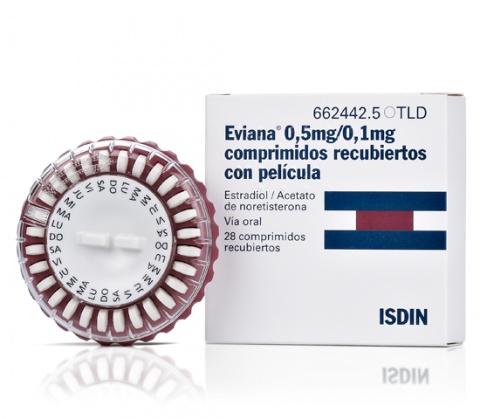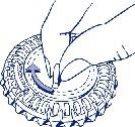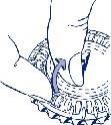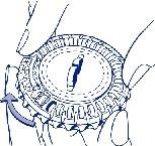

ЕВІАНА 0,5 мг/0,1 мг ТАБЛЕТКИ, ПОКРИТІ ПЛІВКОВОЮ ОБОЛОНКОЮ


Інструкція із застосування ЕВІАНА 0,5 мг/0,1 мг ТАБЛЕТКИ, ПОКРИТІ ПЛІВКОВОЮ ОБОЛОНКОЮ
Вступ
Опис: інформація для користувача
Евіана 0,5 мг/0,1 мг покриті таблетки
естрадіол/ацетат норетистерону
Прочитайте уважно весь опис перед тим, як почнете приймати цей лікарський засіб, оскільки
він містить важливу інформацію для вас.
- Збережіть цей опис, оскільки вам може знадобитися знову його прочитати.
- Якщо у вас є якісь питання, проконсультуйтеся з вашим лікарем або фармацевтом.
- Цей лікарський засіб призначений тільки вам, і не слід давати його іншим людям, навіть якщо вони мають相同ні симптоми, оскільки це може їм нашкодити.
- Якщо ви відчуваєте побічні ефекти, проконсультуйтеся з вашим лікарем або фармацевтом, навіть якщо це можливі побічні ефекти, які не вказані в цьому описі. Див. розділ 4.
Зміст опису
- Що таке Евіана і для чого вона використовується
- Що вам потрібно знати перед тим, як почати приймати Евіану
- Як приймати Евіану
- Можливі побічні ефекти
- Збереження Евіани
- Зміст упаковки та додаткова інформація
1. Що таке Евіана і для чого вона використовується
Евіана - це комбінована гормональна терапія (ГТ). Вона містить два типи жіночих гормонів, естроген і прогестаген. Евіана використовується у жінок після менопаузи, чиї останній природний період стався як мінімум 1 рік тому.
Евіана використовується для:
Зняття симптомів, які виникають після менопаузи
Під час менопаузи кількість естрогенів, які виробляє організм жінки, зменшується. Це може викликати симптоми, такі як жар у обличчі, шиї та грудях ("потіння"). Евіана знімає ці симптоми після менопаузи. Евіану призначатимуть тільки якщо симптоми суттєво ускладнюють вашу повсякденне життя.
Евіану призначатимуть жінкам, яким не видалили матку і чиї періоди закінчилися більше року тому.
Досвід лікування жінок старше 65 років обмежений.
2. Що вам потрібно знати перед тим, як почати приймати Евіану
Медична історія та періодичні огляди
Використання ГТ пов'язано з ризиками, які потрібно враховувати перед тим, як вирішити почати приймати її або продовжувати приймати.
Досвід лікування жінок з пременопаузою (через відмову яєчників або хірургічне втручання) обмежений. Якщо у вас є пременопауза, ризики ГТ можуть бути іншими. Проконсультуйтеся з вашим лікарем.
Перед тим, як почати (або відновити) ГТ, лікар запитає вас про вашу медичну історію та історію вашої сім'ї. Він може вирішити провести фізичний огляд, який може включати огляд грудей або внутрішній огляд, якщо це необхідно.
Після того, як ви почнете приймати Евіану, вам потрібно буде проходити періодичні огляди (як мінімум 1 раз на рік). Під час цих оглядів ви зможете обговорити з лікарем користь і ризики продовжування лікування Евіаною.
Пасуйте регулярно проводити огляди грудей, як це рекомендує ваш лікар.
Не приймайте Евіану
Якщо вам притаманна одна з наступних клінічних ситуацій. Якщо у вас є сумніви щодо одного з наступних пунктів, спитайте вашого лікаряперед тим, як приймати Евіану.
Не приймайте Евіану:
- Якщо у вас є, був або ви підозрюєте, що можете мати рак молочної залози.
- Якщо у вас є, був або ви підозрюєте, що можете мати рак клітин, які покривають матку
(рак ендометрію) або інший рак, залежний від естрогенів.
- Якщо ви страждаєте на будь-яке вагінальне кровотечение невідомої причини.
- Якщо у вас є надмірне загустіння шару, який покриває матку (гіперплазія ендометрію), яке не лікується.
- Якщо у вас є або ви мали колись кров'яні згустки в вені (тромбоемболія), як у ногах (глибока венозна тромбоз), так і в легенях (легенева емболія).
- Якщо у вас є порушення згортання крові (наприклад, дефіцит білка С, білка С або антитромбіну).
- Якщо у вас є або ви мали колись захворювання, викликані кров'яними згустками в артеріях, такі як інфаркт міокарда, інсульт або стенокардія.
- Якщо у вас є або ви мали колись захворювання печінки та аналіз функції печінки ще не нормалізувався.
- Якщо у вас є рідкісне спадкове захворювання крові, яке називається "порфірія".
- Якщо ви алергічні (гіпersenситивні) до естрадіолу, ацетату норетистерону або будь-якого іншого компонента Евіани (переліченого в розділі 6, "Зміст упаковки та додаткова інформація").
Якщо один з цих розладів виникає вперше під час прийому Евіани, припиніть лікування негайно та проконсультуйтеся з лікарем якнайшвидше.
Попередження та застереження
Перед тим, як почати лікування, повідомте вашому лікареві, якщо у вас колись були якісь з наступних проблем, оскільки вони можуть повторитися або погіршитися під час лікування Евіаною. Якщо так, вам потрібно буде проходити періодичні огляди з більшою частотою:
- міоми матки
- загустіння шару, який покриває матку (ендометріоз) або попередня історія загустіння шару, який покриває матку (гіперплазія ендометрію)
- попередня історія утворення кров'яних згустків (див. розділ "Кров'яні згустки в вені (тромбоемболія)")
- збільшення ризику захворювання на рак, чутливий до естрогенів (наприклад, якщо у вас була мати, сестра або бабушка, які мали рак молочної залози)
- артеріальна гіпертензія
- розлад печінки, такий як доброякісна печінкова пухлина
- цукровий діабет
- жовчні камені
- мігрень або сильний головний біль
- захворювання імунної системи, яке впливає на кілька органів тіла (системний червоний вовчак або СЧВ)
- епілепсія
- астма
- захворювання, яке впливає на барабанну перетинку та слух (отосклероз)
- високий рівень жиру в крові (тригліцериди)
- затримка рідини через проблеми з серцем або нирками
- розлад, при якому щитоподібна залоза не виробляє достатньої кількості гормонів (гіпотиреоз), і ви приймаєте замісну терапію щитоподібної залози
- спадкове захворювання, яке викликає повторювані епізоди сильного набухання (ерEDITарний ангіоневротичний едем), або якщо у вас були епізоди швидкого набухання рук, обличчя, ніг, губ, язика, горла (закриття дихальних шляхів) або травного тракту (набутий ангіоневротичний едем)
- непереносимість лактози.
Припиніть лікування Евіаною та повідомте лікаря негайно
Якщо ви помітите будь-які з наступних симптомів під час прийому ГТ:
- будь-який з розладів, перелічених у розділі "Не приймайте Евіану"
- жовтушність шкіри або білкової оболонки очей (жовтяниця). Це можуть бути симптоми захворювання печінки
- набухання обличчя, язика та/або горла та/або труднощі з ковтанням або кропив'янка, разом з труднощами з диханням, які є симптомами ангіоневротичного едему
- велике підвищення артеріального тиску (з симптомами, такими як головний біль, втома, головокружіння)
- головний біль типу мігрені, який може виникнути вперше
- якщо ви вагітні
- якщо ви помітите симптоми кров'яного згустку, такі як:
- запалення з болем і почервонінням ніг
- раптовий біль у грудях
- труднощі з диханням
Для більшої інформації див. розділ "Кров'яні згустки в вені (тромбоемболія)".
Примітка:Евіана не є контрацептивом. Якщо минуло менше 12 місяців з моменту вашого останнього місячного періоду або вам менше 50 років, вам може все ще знадобитися використовувати контрацептивний метод для запобігання вагітності. Проконсультуйтеся з лікарем.
ГТ та рак
Надмірне загустіння слизової оболонки матки (гіперплазія ендометрію) та рак слизової оболонки матки (рак ендометрію)
ГТ тільки з естрогеном збільшує ризик надмірного загустіння слизової оболонки матки (гіперплазія ендометрію) та раку слизової оболонки матки (рак ендометрію).
Прогестаген в Евіані захищає від цього додаткового ризику.
Порівняння
У жінок у віці 50-65 років з цілою маткою, які не приймають ГТ, діагностується в середньому 5 випадків раку ендометрію на 1000 жінок.
У жінок з цілою маткою у віці 50-65 років, які приймають ГТ тільки з естрогеном, діагностується від 10 до 60 випадків раку ендометрію на 1000 жінок (тобто від 5 до 55 додаткових випадків), залежно від дози та тривалості лікування.
Нерегулярне кровотечение
Ви можете мати нерегулярне кровотечение або крововиливи (плями) протягом перших 3-6 місяців прийому Евіани. Однак, якщо нерегулярне кровотечение:
- триває більше 6 місяців
- починається після прийому Евіани протягом більше 6 місяців
- продовжується після припинення прийому Евіани
ви повинні проконсультуватися з лікарем якнайшвидше.
Рак молочної залози
Дані свідчать про те, що використання ГТ з естрогеном-прогестагеном або тільки з естрогеном збільшує ризик захворювання на рак молочної залози. Додатковий ризик залежить від тривалості прийому ГТ.
Додатковий ризик стає очевидним після 3 років прийому. Після припинення ГТ додатковий ризик зменшується з часом, але ризик може зберігатися протягом 10 років або більше, якщо ви приймали ГТ протягом більше 5 років.
Порівняння
У жінок у віці 50-54 років, які не приймають ГТ, діагностується в середньому 13-17 випадків раку молочної залози на 1000 жінок протягом 5 років.
У жінок у віці 50 років, які починають приймати ГТ з естрогеном-прогестагеном протягом 5 років, діагностується від 16 до 17 випадків на 1000 жінок (тобто від 0 до 3 додаткових випадків).
У жінок у віці 50 років, які починають приймати ГТ з естрогеном-прогестагеном протягом 5 років, діагностується від 21 випадку на 1000 жінок (тобто від 4 до 8 додаткових випадків).
У жінок у віці 50-59 років, які не приймають ГТ, діагностується в середньому 27 випадків раку молочної залози на 1000 жінок протягом 10 років.
У жінок у віці 50 років, які починають приймати ГТ тільки з естрогеном протягом більше 10 років, діагностується 34 випадки на 1000 жінок (тобто 7 додаткових випадків).
У жінок у віці 50 років, які починають приймати ГТ з естрогеном-прогестагеном протягом 10 років, діагностується 48 випадків на 1000 жінок (тобто 21 додатковий випадок).
Перевіряйте ваші груди регулярно. Проконсультуйтеся з лікарем, якщо ви помітите будь-які зміни, такі як:
- зморшки на шкірі
- зміни в сосках
- будь-який шишка, який ви можете побачити або відчувати.
Крім того, рекомендується брати участь у програмах огляду грудей, коли вони вам пропонуються.
Під час огляду грудей важливо повідомити вашому медичному працівнику, що ви приймаєте ГТ, коли він робить рентгенологічний огляд, оскільки цей лікарський засіб може збільшувати густину грудей, що може вплинути на результат мамографії. Коли густина грудей більша, можливо, що мамографія не виявить усіх шишок.
Рак яєчників
Рак яєчників трапляється рідше, ніж рак молочної залози. Використання ГТ з естрогеном-прогестагеном або тільки з естрогеном асоціюється з легким збільшенням ризику захворювання на рак яєчників.
Ризик захворювання на рак яєчників змінюється з віком. Наприклад, у жінок у віці 50-54 років, які не приймають ГТ, спостерігається близько 2 випадків раку яєчників на 2000 жінок протягом 5 років. У жінок, які приймають ГТ протягом 5 років, спостерігається близько 3 випадків на 2000 жінок (тобто близько 1 додаткового випадку).
Вплив ГТ на серце та кровообіг
Кров'яні згустки в вені (тромбоемболія)
Ризик кров'яних згустків у венахприблизно в 1,3-3 рази вищий у жінок, які приймають ГТ, ніж у тих, хто не приймає, особливо протягом першого року.
Кров'яні згустки можуть бути серйозними, і якщо один з них потрапляє в легені, він може викликати біль у грудях, труднощі з диханням, синкопу або навіть смерть.
Ймовірність захворювання на кров'яні згустки у венах буде вищою з віком та якщо є один з наступних факторів. Якщо одна з цих ситуацій може застосовуватися до вас, повідомте вашому лікареві:
- ви не зможете ходити протягом тривалого часу через велику хірургічну операцію, травму або захворювання (див. також розділ 3, "Якщо вам потрібно пройти операцію")
- у вас є значна надмірна вага (ІМТ > 30 кг/м2)
- ви страждаєте на порушення згортання крові, яке потребує тривалого лікування препаратами для профілактики кров'яних згустків
- у одного з ваших близьких родичів колись був кров'яний згусток у ногах, легенях або інших органах
- ви страждаєте на системний червоний вовчак (СЧВ)
- у вас є рак.
Для того щоб дізнатися про симптоми, які викликає кров'яний згусток, див. розділ "Припиніть лікування Евіаною та повідомте лікаря негайно".
Порівняння
Вважається, що протягом 5 років у середньому 4-7 жінок на 1000 жінок у віці 50 років, які не приймають ГТ, будуть страждати на кров'яний згусток у вені.
У жінок у віці 50 років, які приймають ГТ з естрогеном-прогестагеном протягом 5 років, буде від 9 до 12 випадків на 1000 жінок (тобто 5 додаткових випадків).
Серцеві захворювання (інфаркт міокарда)
Не доведено, що ГТ запобігає інфаркту міокарда. Жінки старше 60 років, які приймають ГТ з естрогеном-прогестагеном, мають легкий підвищений ризик розвитку серцевих захворювань порівняно з тими, хто не приймає ГТ.
Інсульт
Ризик інсульту приблизно в 1,5 рази вищий у жінок, які приймають ГТ, ніж у тих, хто не приймає. Кількість додаткових випадків інсульту через використання ГТ збільшується з віком.
Порівняння
Вважається, що протягом 5 років у середньому 8 жінок на 1000 жінок у віці 50 років, які не приймають ГТ, будуть страждати на інсульт.
У жінок у віці 50 років, які приймають ГТ, кількість випадків буде складати 11 на 1000 жінок протягом 5 років (тобто 3 додаткових випадки).
Інші розлади
ГТ не запобігає втраті пам'яті. Є дані про підвищений ризик втрати пам'яті у жінок, які починають приймати ГТ після 65 років. Проконсультуйтеся з лікарем.
Використання з іншими лікарськими засобами
Деякі лікарські засоби можуть вплинути на дію Евіани. Це може викликати нерегулярне кровотечение.
Такі лікарські засоби включають:
- Лікарські засоби проти епілепсії (наприклад, фенобарбітал, фенітоїн та карбамазепін)
- Лікарські засоби проти туберкульозу (наприклад, рифампіцин та рифабутин)
- Лікарські засоби проти ВІЛ (наприклад, невірапін, ефавіренз, ритонавір та нелфінавір)
- Лікарські засоби проти гепатиту С (наприклад, телапревір)
- Препарати на основі рослин, які містять траву Святого Івана (Hypericum perforatum).
.
ГТ може вплинути на дію деяких лікарських засобів:
- Лікарські засоби проти епілепсії (ламотриджин), оскільки вони можуть збільшувати частоту конвульсій.
- Лікарські засоби проти гепатиту С (ВГС) (наприклад, комбінований препарат омбітастивір/паритапревір/ритонавір з або без дасабувіру, а також комбінований препарат глекапревір/пібрентасвір) можуть викликати підвищення результатів аналізів крові на функцію печінки (підвищення рівня ферменту печінки АЛТ) у жінок, які приймають комбіновані гормональні контрацептиви (КГК), які містять етинілестрадіол. Евіана містить естрадіол замість етинілестрадіолу. Невідомо, чи може відбуватися підвищення рівня ферменту печінки АЛТ при прийомі Евіани з цим комбінованим препаратом проти ВГС.
Інші лікарські засоби можуть збільшувати дію Евіани:
- Лікарські засоби, які містять кетоконазол (грибковий препарат).
Евіана може вплинути на лікування комбінованим препаратом циклоспорин.
Повідомте вашому лікареві або фармацевтуякщо ви приймаєте або нещодавно приймали будь-який інший лікарський засіб, навіть ті, які придбані без рецепта, препарати на основі рослин або інші природні продукти. Ваш лікар порадить вам.
Аналітичні дослідження
Якщо вам потрібно пройти аналіз крові, повідомте вашому лікареві або персоналу лабораторії, що ви приймаєте Евіану, оскільки цей лікарський засіб може змінювати результати деяких параметрів лабораторних аналізів.
Прийом Евіани з лікарськими засобами та напоями
Таблетки можна приймати з або без їжі чи напоїв.
Вагітність та лактація
Вагітність:Евіана повинна використовуватися тільки у жінок після менопаузи. Якщо ви вагітні, припиніть приймати Евіану та проконсультуйтеся з лікарем.
Лактація:Не приймайте Евіану, якщо ви годуєте грудьми.
Водіння транспортних засобів та використання машин
Евіана не має відомих ефектів на здатність водити транспортні засоби або використовувати машини.
Важлива інформація про деякі компоненти Евіани:
Евіана містить лактозу моногідрат. Якщо у вас є непереносимість деяких цукрів, проконсультуйтеся з лікарем перед тим, як приймати цей лікарський засіб.
3. Як приймати Евіяну
Слідувати точно інструкціям щодо застосування цього лікарського засобу, вказаним вашим лікарем.
У разі сумнівів зверніться до свого лікаря або фармацевта.
Принимайте одну таблетку один раз на добу, приблизно о同じ годину кожного дня.Принимайте таблетку з склянкою води.
Принимайте одну таблетку щодня без перерви.Після прийому 28 таблеток з упаковки диско-календаря вам потрібно продовжити з новою.
Для отримання більшої інформації про використання упаковки календаря зверніться до розділу "ІНСТРУКЦІЇ ДЛЯ КОРИСТУВАЧА", у кінці цього листка.
Ви можете почати лікування Євіяноюбудь-якого дня тижня. Однак, якщо ви змінили інший препарат ТГС, з яким у вас були менструальні кровотечі, почніть нове лікування одразу після закінчення кровотечі.
Ваш лікар повинен призначити вам ефективну дозу та тривалість лікування, яка забезпечить полегшення симптомів. Поговоріть з лікарем, якщо ви вважаєте, що доза надто велика або недостатня.
Якщо ви прийняли більше Євіяни, ніж мали б
Якщо ви прийняли більше Євіяни, ніж мали б, зверніться до свого лікаря або фармацевта якнайшвидше. Прийом більше естрогенів, ніж призначений лікарем, може спричинити у вас чутливість молочних залоз, нудоту, блювоту та/або нерегулярне вагінальне кровотечі (метрорагія). Прийом більше прогестагенів, ніж призначений лікарем, може спричинити у вас депресивний стан, втому, акне та рост волосся на тілі або обличчі (гірсутизм).
Якщо ви забули прийняти Євіяну
Якщо ви забули прийняти таблетку, призначену для прийому о звичайній годині, прийміть її протягом наступних 12 годин. Якщо вже минуло більше 12 годин, прийміть її на наступний день о звичайній годині. Не приймайте подвійну дозу для компенсації забутої дози.
Забуття однієї дози може збільшити ймовірність появи міжменструальних кровотеч та плям, якщо у вас не видалений матка.
Якщо ви припините лікування Євіяною
Якщо ви хочете припинити лікування Євіяною, спочатку поговоріть з лікарем, який пояснить вам наслідки припинення лікування та обговорить з вами інші можливості.
Якщо у вас є будь-які інші питання щодо використання цього лікарського засобу, зверніться до свого лікаря або фармацевта.
Якщо вам потрібно пройти операцію
Якщо ви маєте пройти хірургічну операцію, повідомте хірурга про те, що приймаєте Євіяну. Можливо, вам потрібно буде припинити прийом Євіяни за 4-6 тижнів до операції, щоб зменшити ризик утворення кров'яних згустків (див. розділ "Кров'яні згустки в вені (тромбоемболія)", у розділі 2). Зверніться до лікаря, коли ви можете знову почати приймати Євіяну.
4. Можливі побічні ефекти
Як і всі лікарські засоби, цей лікарський засіб може спричинити побічні ефекти, хоча не всі люди їх відчувають.
Наступні порушення були повідомлені з більшою частотою у жінок, які використовують ТГС, порівняно з тими, хто не використовує:
- рак молочної залози
- анормальний ріст або рак слизової оболонки матки (гіперплазія ендометрія або рак ендометрія)
- рак яєчників
- кров'яні згустки в венах ніг або легенях (тромбоемболія)
- серцево-судинні захворювання
- інсульт
- ймовірна втрата пам'яті, якщо ТГС починається у віці понад 65 років.
Для отримання більшої інформації про ці побічні ефекти див. розділ 2, "Що потрібно знати перед початком прийому Євіяни".
Дуже часті побічні ефекти (можуть впливати на більше 1 з 10 осіб)
- Вагінальне кровотечі.
Часті побічні ефекти (можуть впливати до 1 з 10 осіб)
- Інфекція, викликана грибами, в геніталіях або запалення вагінальної слизової оболонки
- Надмірний ріст слизової оболонки матки (гіперплазія ендометрія)
- Нудота
- Біль у животі (шлунку)
- Біль у спині або шиї
- Біль у руках або ногах
- Головний біль.
Побічні ефекти, які трапляються рідше (можуть впливати до 1 з 100 осіб)
- Алергічні реакції (гіперчутливість)
- Депресія або погіршення існуючої депресії
- Нервозність
- Головокружіння
- Мігрень (див. розділ "Припинення лікування Євіяною", у розділі 2)
- Біль або дискомфорт у молочних залозах
- Запалення або розтягнення живота (шлунка)
- Збільшення ваги через утримання рідини
- Набухання рук і ніг (периферичний едем)
- М'язові спазми в ногах
- Кислотність (диспепсія)
- Акне
- Випадання волосся (алопеція)
- Свербіння або кропив'янка.
Дуже рідкі побічні ефекти (можуть впливати до 1 з 10000 осіб)
- Було повідомлено про загальні алергічні реакції (напр., анафілактична реакція або анафілактичний шок).
Інші побічні ефекти комбінованої ТГС
- Хвороба жовчного міхура
- Різні шкірні захворювання:
- пігментація шкіри, особливо на обличчі та шиї, відома як "відмітини вагітності" (хлоазма)
- червоні та болючі шкірні вузлики (еритема вузликова)
- виразка з виразками або червоними плямами у вигляді цілі (еритема поліморфна).
- червоний або фіолетовий колір шкіри та/або слизових оболонок (пурпура васкулярна)
- Сухість очей
- Зміни у складі сліз.
Повідомлення про побічні ефекти
Якщо ви відчуваєте будь-який побічний ефект, зверніться до свого лікаря або фармацевта, навіть якщо це можливі побічні ефекти, які не вказані в цьому листку. Ви також можете повідомити про них безпосередньо через Систему моніторингу лікарських засобів для людини: https://www.notificaram.es. Повідомляючи про побічні ефекти, ви можете допомогти надати більше інформації про безпеку цього лікарського засобу.
5. Зберігання Євіяни
Тримати цей лікарський засіб поза зоною видимості та досягнення дітей.
Не використовувати цей лікарський засіб після закінчення терміну придатності, вказаного на етикетці та зовнішній упаковці, після "КІНЦЯ". Термін придатності - останній день місяця, який вказано.
Не зберігати при температурі вище 25 °C. Не зберігати в холодильнику.
Тримати упаковку в зовнішній упаковці, щоб захистити її від світла.
Лікарські засоби не повинні викидати в каналізацію або сміття. Зверніться до фармацевта, щоб дізнатися, як позбутися упаковок та лікарських засобів, які вам більше не потрібні. Таким чином, ви допоможете захистити довкілля.
6. Зміст упаковки та додаткова інформація
Склад Євіяни
- Активними речовинами Євіяни є естрадіол та ацетат норетистерона. Кожна таблетка містить 0,5 мг естрадіолу (у вигляді гемігідрату естрадіолу) та 0,1 мг ацетату норетистерона.
- Інші компоненти: моногідрат лактози, кукурудзяний крохмаль, гідроксипропілцелюлоза, стеарат магнію, гіпромелоза, тріацетин та тальк.
Вигляд продукту та вміст упаковки
Покриті таблетки, білі, круглі, діаметром 6 мм. На одній стороні нанесено напис "NOVO 291", а на іншій - логотип Novo-Nordisk (бик Apis).
Упаковки:
- 28 покритих таблеток
- 3 x 28 покритих таблеток
Можливо, що тільки деякі розміри упаковок будуть реалізовані.
Власник дозволу на реалізацію та відповідальна особа за виробництво
Власник:
Isdin S.A.
Provençals 33
Барселона 08019
Іспанія
Відповідальна особа за виробництво:
Novo Nordisk A/S
Novo Allé
DK-2880 Bagsværd
Данія
Цей лікарський засіб дозволений у країнах-членах Європейського економічного простору під наступними назвами:
Activelle: Австрія, Португалія
Activelle low: Данія, Ісландія, Італія
Activelle minor: Бельгія, Люксембург
Eviana: Естонія, Угорщина, Нідерланди, Норвегія, Іспанія, Швеція
Noviana: Фінляндія
Дата останньої ревізії цього листка:вересень 2024
Інші джерела інформації
Детальна інформація про цей лікарський засіб доступна на сайті {назва держави/агентства}:
ІНСТРУКЦІЇ ДЛЯ КОРИСТУВАЧА
Як використовувати упаковку диско-календаря
- Встановити вказівник дня
Повернути внутрішній диск та встановити день тижня перед закритим отвором з пластиковою ланкою.

- Як витягнути першу таблетку
Зламати пластикову ланку та витягнути першу таблетку.


- Перемістити діал кожен день
Просто повернути 1 позицію прозорий диск за годинниковою стрілкою, як вказано стрілкою. Витягнути наступну таблетку. Пам'ятайте, що потрібно приймати тільки 1 таблетку на добу.
Прозорий диск можна повернути тільки після витягнення відповідної таблетки.

- Країна реєстрації
- Діючі речовини
- Потрібен рецептТак
- Виробник
- Інформація є довідковою і не є медичною порадою. Перед прийомом будь-яких препаратів обов'язково проконсультуйтеся з лікарем. Oladoctor не несе відповідальності за медичні рішення, прийняті на основі цього контенту.
- Альтернативи до ЕВІАНА 0,5 мг/0,1 мг ТАБЛЕТКИ, ПОКРИТІ ПЛІВКОВОЮ ОБОЛОНКОЮФорма випуску: ТАБЛЕТКА, 1 мг / 0,5 мгДіючі речовини: norethisterone and estrogenВиробник: Isdin S.A.Потрібен рецептФорма випуску: КАПСУЛА, 1 мг / 100 мгДіючі речовини: progesterone and estrogenВиробник: Theramex Ireland LimitedПотрібен рецептФорма випуску: ТАБЛЕТКА, 2 мг дієногесту; 2 мг валерату естрадіолуДіючі речовини: dienogest and estrogenВиробник: Bayer Hispania S.L.Потрібен рецепт
Аналоги ЕВІАНА 0,5 мг/0,1 мг ТАБЛЕТКИ, ПОКРИТІ ПЛІВКОВОЮ ОБОЛОНКОЮ в інших країнах
Найкращі аналоги з тією самою діючою речовиною та терапевтичним ефектом.
Аналог ЕВІАНА 0,5 мг/0,1 мг ТАБЛЕТКИ, ПОКРИТІ ПЛІВКОВОЮ ОБОЛОНКОЮ у Польша
Лікарі онлайн щодо ЕВІАНА 0,5 мг/0,1 мг ТАБЛЕТКИ, ПОКРИТІ ПЛІВКОВОЮ ОБОЛОНКОЮ
Консультація щодо дозування, побічних ефектів, взаємодій, протипоказань та поновлення рецепта на ЕВІАНА 0,5 мг/0,1 мг ТАБЛЕТКИ, ПОКРИТІ ПЛІВКОВОЮ ОБОЛОНКОЮ – за рішенням лікаря та згідно з місцевими правилами.





